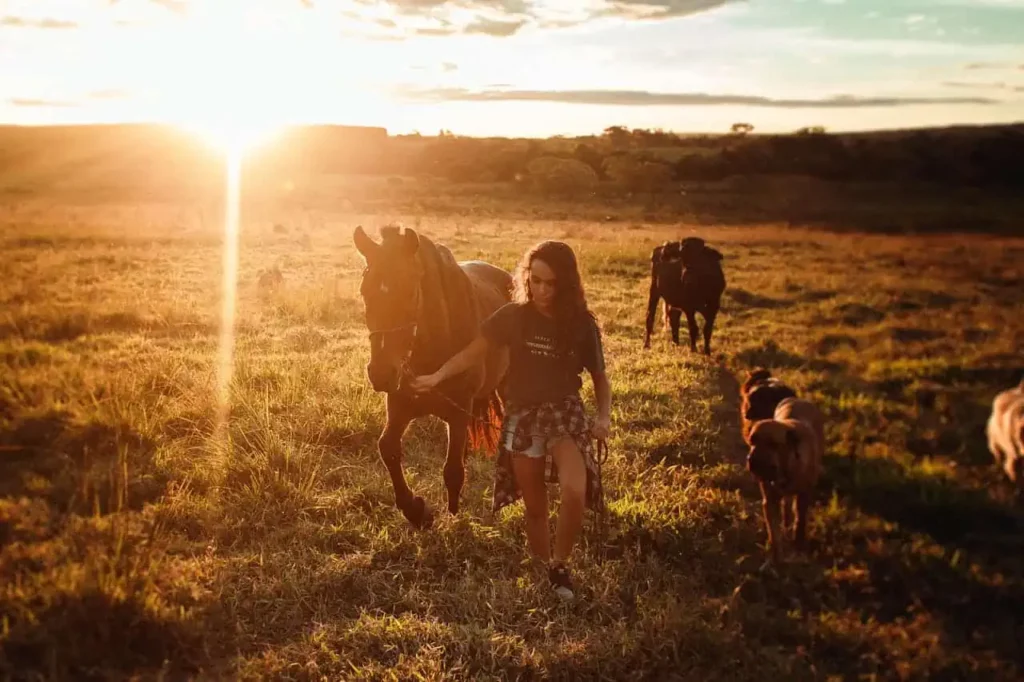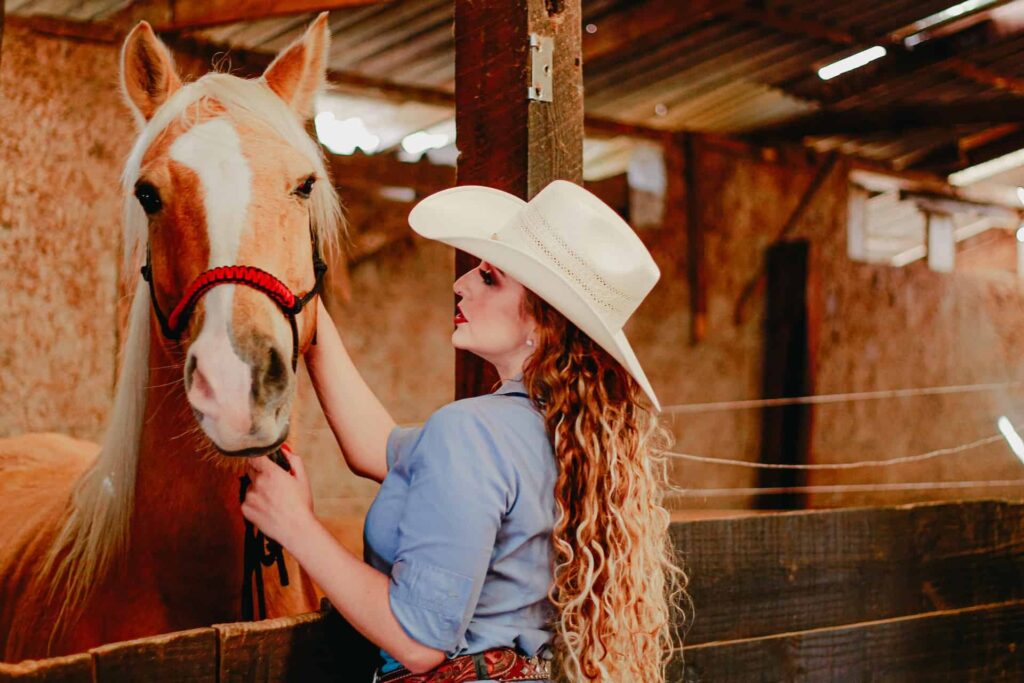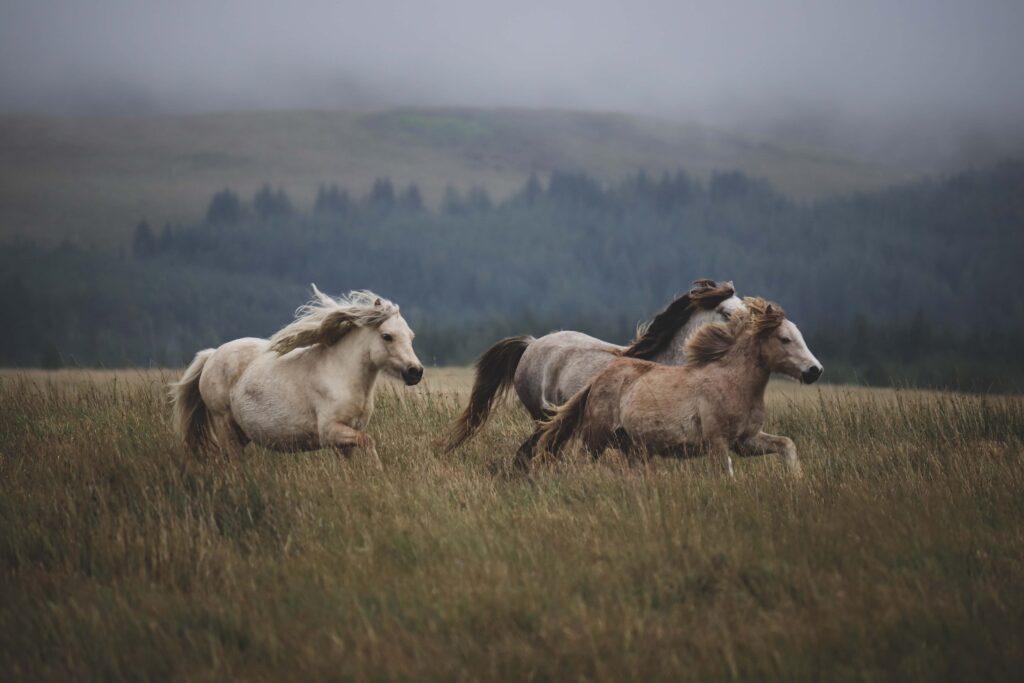Maintaining the comfort and health of horses during hot weather is crucial for their well-being. Horses, like many animals, can suffer from heat stress, which impacts their overall health and performance.
As temperatures rise, the need for effective ways to keep horses cool becomes paramount. Employing the right cooling strategies is not only a matter of comfort but also critical to preventing heat-related illnesses.
Strategies range from optimizing stable conditions to implementing specific hydration techniques, all tailored to ensure a horse’s core temperature is managed effectively.
Horse owners must understand the signs of heat stress and the diverse cooling methods available. Certain techniques, such as providing shade and adequate ventilation, are essential in creating an optimal stable environment.
Nutrition management also plays a role in how well horses can cope with increased temperatures. Additionally, recognizing the unique needs of at-risk horses is necessary to prevent heat stress and ensure their safety.
These methods, alongside a management plan that considers both the horse and its environment, are vital for their care during hot weather periods.
Key Takeaways
- Monitoring and managing core temperature is essential for horse health in hot weather.
- Stable management, hydration, and nutrition are key to preventing equine heat stress.
- Tailored cooling techniques are critical for at-risk horses during high temperatures.
Understanding Equine Heat Stress
Equine heat stress is a critical concern during hot weather, particularly in high temperatures and humidity that herald summer’s toughest days. Horses are susceptible to the effects of heat, which can compromise horse health if not managed properly.
Key Factors:
- Temperature: As the mercury rises, so does the risk of heat-related issues.
- Humidity: High humidity impairs a horse’s ability to cool down through sweating.
- Hydration: Adequate water intake is essential to prevent dehydration.
Horse owners must understand the balance between electrolytes and hydration to maintain a comfortable state for their horses. Electrolytes are vital in regulating a horse’s body fluids, and a deficiency can exacerbate stress.
Signs of Heat Stress in Horses:
- Increased heart rate
- Excessive sweating or anhidrosis (lack of sweating)
- Lethargy
- Depression
Cooling Strategies:
- Provide shade and ventilation.
- Use a cool water application to assist in lowering body temperature.
- Electrolyte supplements can be considered to replace lost minerals through sweating.
In extreme cases, if a horse’s body temperature escalates dangerously, it can lead to heatstroke, an emergency that requires immediate veterinary attention. Regular monitoring during prolonged hot spells helps detect early signs of heat stress, allowing for quick action to alleviate the condition.
Optimizing Stable Conditions
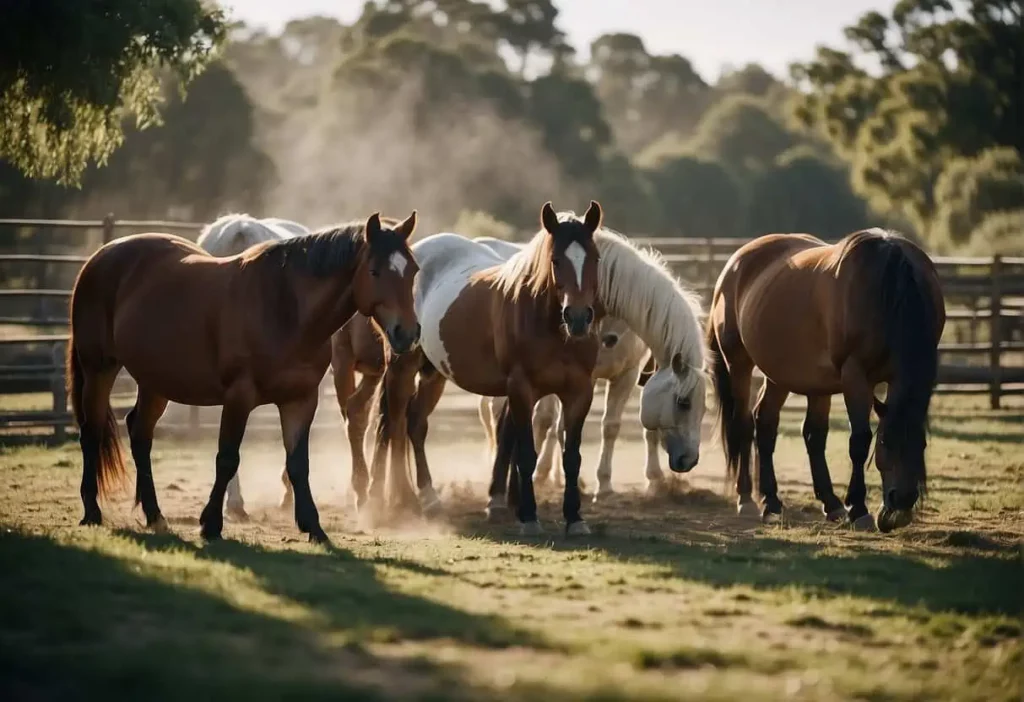
In the pursuit of maintaining a cool environment for horses during periods of increased temperatures, attention to stable conditions is paramount.
Strategic enhancements within the stable structure are essential to ensure effective cooling and air quality for equine health and comfort.
Ventilation and Air Circulation
Ventilation is crucial in regulating the temperature inside a horse’s stall and overall barn area.
Strategic placement of fans can generate necessary air movement, which is instrumental in mitigating heat accumulation.
When incorporating fans, they must be secured properly in positions that do not pose risks to the horses but offer optimal air circulation.
Equine barns benefit from natural air flow which can be maximized through the correct design and orientation of the structure.
Large doors and windows should be incorporated at opposite ends of the barn to create a cross-breeze effect. This promotes continuous air exchange, effectively reducing stagnant hot air.
Utilizing shade from trees or other constructions can dramatically impact the internal temperature of a barn. Structures positioned to take advantage of shade during peak sun hours will experience a natural cooling effect.
Insulation plays a dual role in stabilizing a stable climate by keeping it warmer in winter and cooler in summer. Including reflective or radiant barrier insulation under the roof can help deflect heat away from the barn’s interior.
Beyond structural changes, good maintenance practices such as removing manure and wet bedding promptly ensure that the stable condition is not contributing to excess heat and humidity which can exacerbate the discomfort for horses.
Effective Hydration Strategies
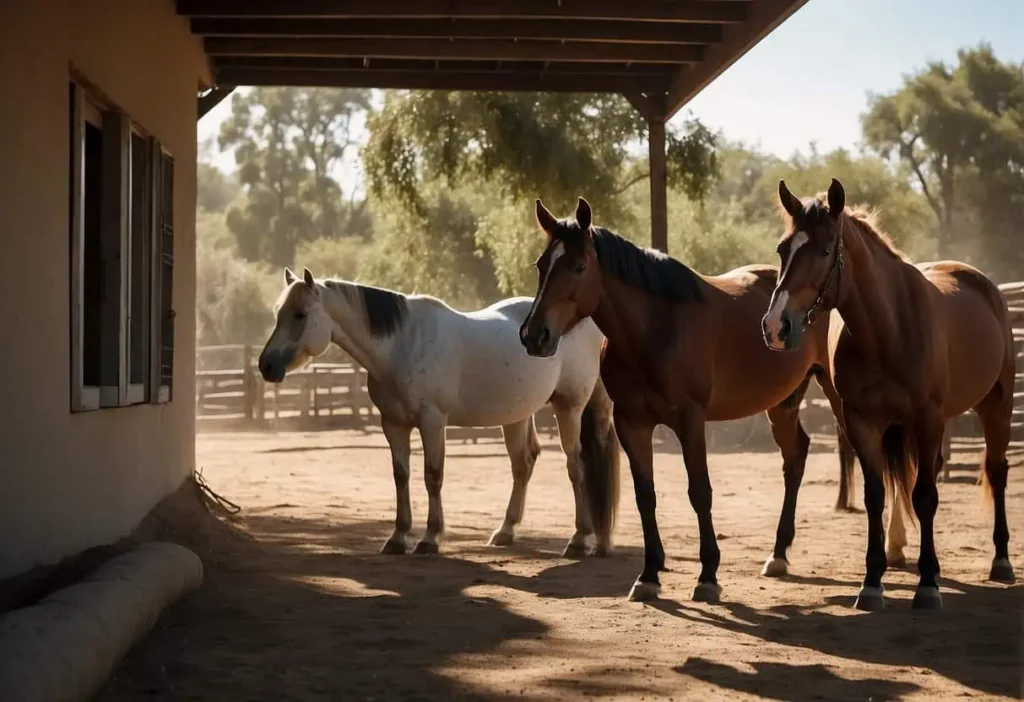
Maintaining optimal hydration in horses is critical to prevent heat stress during hot weather conditions.
Providing consistent access to fresh, cool water and understanding the balance of electrolytes are paramount in supporting their thermoregulation.
Providing Ample Water Sources
It is essential to ensure that horses have continuous access to fresh water.
Water sources such as buckets or tanks should be placed in multiple, easily accessible locations.
These receptacles need to be kept clean to encourage horses to drink regularly. During periods of high temperature, water consumption can double, so checking and refilling water sources frequently is important to keep the water fresh and cool.
Understanding Electrolyte Balance
Horses lose electrolytes through sweat, especially in hot weather.
A balance of electrolytes is vital for proper hydration and muscle function.
One may provide salt blocks in the pasture or add electrolytes to the horse’s feed to replenish lost minerals.
However, it’s also critical to offer free-choice salt to promote hydration, as horses will only consume what they need.
Monitoring the color of a horse’s gums and the capillary refill time can help gauge their electrolyte and hydration status.
Proper Nutrition Management

Managing a horse’s diet during high temperatures is crucial to prevent heat stress and maintain their energy levels.
Ensuring that horses receive the correct balance of nutrition while being mindful of their electrolyte needs, can help keep them comfortable and healthy in hot and humid conditions.
Feeding During High Temperatures
Forage Selection: High-quality forage should be the foundation of a horse’s diet in hot weather.
Forage is a natural source of energy and helps maintain gut health.
Offer a mix of grasses and hays that are suitable for the climate, keeping in mind that horses may require additional forage when pastures are less lush in the summer months.
Hydration and Salt Intake: Always provide access to clean, cool water to prevent dehydration.
Consider adding an electrolyte supplement or a salt block to the horse’s diet to replenish the salt and other minerals lost through sweat, thereby reducing the risk of heat stress.
Energy Requirements: Be aware that a horse’s energy needs might vary with the ambient temperature.
Limit high-fat diets as they can increase metabolic heat production during digestion.
Instead, offer a balanced diet that meets the horse’s energy requirements without exacerbating heat production.
Management of Horse and Environment
Effective management of horses in hot weather involves proactive measures to prevent heat stress and maintain their comfort.
Attention to detail in sunburn and fly protection, thoughtful pasture management, and diligent health monitoring form the trifecta of a suitable environment for horses during the warmer months.
Sunburn and Fly Protection
Horses are susceptible to sunburn, especially those with light-colored coats or pink skin.
It’s critical to provide them with ample shade and use protective gear, such as fly masks with UV protection, to minimize sun exposure.
Products specifically designed for horses can prevent sunburn on sensitive areas like the nose.
Concurrently, flies can cause significant stress and irritation, so regular application of fly repellents and the use of fly sheets are essential measures.
Providing a space with adequate ventilation while also protecting against flies will ensure a more comfortable environment for the horse.
Turnout and Pasture Management
The timing of turnout is paramount; it should ideally occur during cooler parts of the day, such as early morning or late evening.
Horses benefit from pastures that offer shade through trees or run-in sheds to escape the heat.
When considering exercise routines, they should be adjusted to prevent heat stress, with lighter workouts scheduled for the coolest hours.
Proper ventilation inside the barn and a consistent supply of fresh, clean water are essential to help with cooling and to prevent dehydration.
Health Monitoring and Veterinary Care
Regular monitoring of a horse’s heart rate, respiratory rate, and the color of their mucous membranes provides early indications of distress due to heat.
Any signs of dehydration, diarrhea, or anhidrosis (inability to sweat properly), should prompt immediate action.
Maintaining a close relationship with a veterinarian (DVM) is essential for developing a plan to manage heat stress and ensuring appropriate electrolyte balance.
Scheduling regular check-ups during hot weather can aid in identifying any stress-related issues before they evolve into conditions like heat stroke.
Heat Reduction Techniques
To safeguard horses from the dangers of heat stress in sweltering climates, it is crucial to employ targeted heat reduction techniques.
Strategic Exercise and Work Scheduling
Scheduling exercise and work during the cooler parts of the day, ideally early morning or late evening, can significantly mitigate the risk of heat stress.
Horses need to engage in activities when the temperatures are less intense to maintain their comfort and energy levels, reducing the potential for sweating and dehydration.
Immediate Cooling Practices
After exercise or work, immediate cooling practices such as hosing the horse with water and then scraping off the excess can expedite the lowering of the body’s temperature.
Employing fans or seeking shaded areas contributes to creating a comfortable and cool environment, minimizing the incidence of heat stroke.
Transitioning Between Climates
When horses transition from cooler to hot and humid climates, it is crucial to allow time for acclimatization.
Incremental exposure to higher temperatures helps horses adapt and adjust their physiological responses to heat.
Proper hydration should be continuously monitored to ensure the horses remain adequately hydrated during this transition.
Special Considerations for At-Risk Groups
Certain groups of horses require additional attention during hot weather to prevent issues such as dehydration, heat stress, and anhidrosis. It is crucial to tailor cooling strategies for senior horses, young foals, and breeds that are particularly susceptible to heat.
Senior Horses and Young Foals
Senior Horses: They are more prone to heat stress due to reduced efficiency in regulating body temperature. Key strategies include:
- Access to Shade: Ensure they have shelter from direct sunlight.
- Hydration: Availability of fresh water is essential. Consider providing a salt block to encourage drinking and prevent dehydration.
- Monitoring: Watch for signs of distress, such as lethargy or lack of appetite, which may indicate heat-related issues like colic.
Young Foals: Their thermoregulatory systems are not fully developed, making them vulnerable to temperature extremes. Important care measures include:
- Climate Adaptation: Allow them to gradually adapt to the heat to build their tolerance.
- Constant Supervision: Foals should be monitored more frequently for any abnormal behavior or signs of heat stress.
Breeds Susceptible to Heat
Some breeds, due to their physiology or coat, do not cope well with high temperatures and humidity. To protect these horses:
- Acclimatization: Provide gradual exposure to heat to help adapt their bodies.
- Cooling Techniques: Implement active cooling methods, such as hosing down with water or the use of fans.
- Electrolyte Balance: Their diet may need adjustment to replenish electrolytes lost through sweat.
Frequently Asked Questions
In hot weather, ensuring the well-being of horses is crucial. This section answers common questions about how to effectively manage and protect horses from extreme temperatures.
What temperature is too hot for horses to be outside?
Horses begin to experience stress when temperatures rise above 90°F, especially if the humidity is also high. It’s crucial to provide adequate shade and hydration during these conditions.
How can I cool my horse down quickly after riding?
After riding, one can rapidly cool a horse by offering water to drink and applying cool water to areas where large blood vessels are close to the skin, such as the legs and neck. Ensuring good airflow for evaporation is also beneficial.
What are the signs of heat stress or heat colic in horses?
Signs of heat stress in horses include excessive sweating, rapid breathing, lethargy, and an elevated heart rate. In more severe cases, they may exhibit signs of colic such as restlessness, pawing, and rolling.
Are there effective home remedies for keeping horses cool during extreme heat?
Effective home remedies for cooling horses include providing constant access to fresh water, installing fans in stables, and using misting systems to increase evaporative cooling.
Should you hose a horse down as a method to manage heat?
Hosing a horse down with cool water is an effective method for managing heat. One should focus on the legs and underside, and scraping excess water off can aid in the cooling process.
What extra precautions should be taken for senior horses in hot weather?
Senior horses may require additional care. They might need more frequent breaks in the shade and access to electrolytes.
These help replenish salts lost through sweating. Senior horses also need regular monitoring for signs of heat-related issues.
Last Updated on February 23, 2024 by Nate Dewsbury
